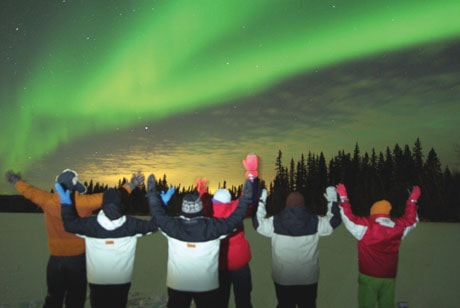When the ancient Greeks looked at the night sky, they saw pictures in the stars and used storytelling to explain the images or constellations.
Virtually every ancient culture has developed theories to explain the stars and mankind’s place in the universe. The Greeks, Romans, Egyptians, Persians and First Nations people spent a great deal of time observing the heavens.
But it seems that the modern world has lost some of its fascination with the wonders that make up the night sky. We have stopped gazing heavenward and spend our time rushing around fulfilling earthly pursuits.
It’s time to start re-examining the stars. The United Nations has designated 2009 as the international year of astronomy and every Canadian is being challenged to have a Galileo Moment before the end of this year.
Four hundred years ago, Galileo Galilei became the first person to use a telescope to take a closer look at the stars, planets and other celestial bodies that make up the universe. As he gazed through his telescope, Galileo gained a new perspective on Earth’s place in the vast universe and became the father of astronomy.
A Galileo Moment is something that causes you to ponder your place in the universe. Although it sounds daunting, having a Galileo Moment is actually something the entire family can participate in.
Here are a few ideas to help you have a Galileo Moment with your family before the end of 2009.
Visit the Rothney Astrophysical Observatory —The University of Calgary’s Rothney Astrophysical Observatory (RAO) is a facility dedicated to expanding mankind’s knowledge of the universe and educating the public about the wonders of astronomy.
It has the second largest telescope in Canada and the only telescope in Canada dedicated to searching for potential killer asteroids.
The site provides an unobstructed view of the entire night sky and there is an onsite interpretive centre with educational displays on astronomy.
Although the observatory is open at select times for drop-in daytime visits, the best way to experience it is during an evening open house event.
During open house events, there are special presentations on astronomy, the telescope is operating and astronomers are on hand to answer questions. These events happen on select Saturday evenings from 8 to 11 p.m. and typically cost $20 per car.
Dates: Oct 24 — Dark Skies Open House; Nov. 21 — Northern Lights Open House; Dec. 19 — Winter Solstice Open House.
Website: www.ucalgary.ca/rao/
Telus World of Science Calgary — Telus World of Science Calgary offers a number of astronomy programs that can help novices learn about the science of astronomy. Programs include a Junior Skywatcher’s Program, a Junior Skywatcher’s Star Show, Explore the Sky and How to Use Your Telescope.
The Science Centre also offers a free Stargazing program on Friday evenings. Every clear Friday night (weather permitting), members of the Calgary Centre of the Royal Astronomical Society of Canada aim telescopes at the planets, the moon and the stars, and visitors can look through the telescopes for free.
Dates: Programs take place on various dates. Consult the website or call 403-268-8307 for more details.
Website: calgaryscience.ca or astronomycalgary.com/events
Take a tour of the northern lights in Fort McMurray —The dancing lights of the aurora borealis are visible in Fort McMurray on most cold, clear winter nights. To the Inuit people, the lights were spirits on their way to heaven. Others believe the lights are created when former lost souls find their way to heaven and light up the path for others to follow.
Displays can last for a few minutes to several hours and it can be hard to predict exactly how the lights will look on any given night.
Most often, the northern lights are white and green, but on rare occasions the night sky is ablaze in shades of red. No matter the colour, the aurora borealis is an awe-inspiring sight.
There are several tour operators that offer formal aurora-viewing tours, including Alto-Can Aurora Tours (www.altocan.ab.ca or 780-452-5187), Aurora Adventures (aurorabedandbreakfast.com or 780-799-3329) and Aurora Tours (picturetrail.com or 780-334-2292).
Website: www.fortmcmurraytourism.com/index.php?page_id=1003
Backyard fun — Galileo made his first dramatic discovery as he studied Jupiter through his telescope in January 1610. Through careful observation, he noticed four stars near the planet that changed position over a period of days and correctly deduced that these stars were the moons of Jupiter.
He also surmised that these moons revolved around Jupiter, a finding that conflicted with the then popular belief that all celestial bodies orbited the earth.
To honour this discovery, these moons are now known as the Galilean Moons.
You can experience Galileo’s discovery first-hand with a good pair of binoculars.
To locate Jupiter, print off a sky chart for your location and choice of time at skyandtelescope.com/skychart. If you wait until Jupiter is fairly high in the night sky and hold your binoculars steady, you should be able to see the Galilean moons just like Galileo did nearly 400 years ago. A backyard telescope will reveal even more detail, including the shadows of the moons and the layered cloud belts of Jupiter’s atmosphere.
Register your Galileo Moment and get launched into space (sort of): If you attend an official astronomical event or presentation in 2009, you will be given an Astro Trading card with a number on it.
Once you have the card, you can register your name in the Canada-wide official Galileo Moment listing. All the names that are collected at the end of 2009 will be launched into space aboard the NEOSsat Satellite.
For more details, visit astronomy2009.ca
Debbie Olsen is a Lacombe-based freelance writer. If you have a travel story you would like to share or know someone with an interesting travel story who we might interview, please email: DOGO@telusplanet.net or write to: Debbie Olsen, c/o Red Deer Advocate, 2950 Bremner Ave., Red Deer, T4R 1M9.
